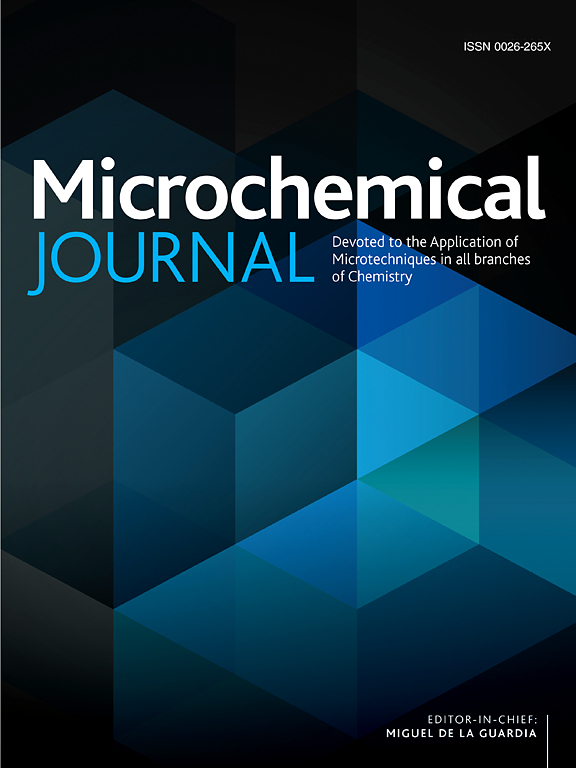基于HCR信号放大和分光光度法和电化学磁分离的双模检测平台测定玉米赤霉烯酮
IF 4.9
2区 化学
Q1 CHEMISTRY, ANALYTICAL
引用次数: 0
摘要
玉米赤霉烯酮(ZEN)是一种高度危险的真菌毒素,对人类和动物都是致命的。本文提出了一种以杂化链反应(HCR)和链霉亲和素修饰磁珠(sa - mb)作为信号放大器的具有电化学和比色特征的双模生物传感器用于ZEN检测。其中,生物素修饰的ZEN-cDNA通过链霉亲和素与生物素的特异性结合,被sa - mb富集。当靶标存在时,ZEN-Apt与靶标结合并释放ZEN-cDNA以触发HCR。亚甲基蓝可以作为信号分子插入dsDNA中,因此靶物浓度越高,HCR被触发越多,产生更多双链DNA,放大信号。相反,HCR触发越多,溶液中保留的DNA就越少,导致吸光度降低。因此,被检测物质的浓度与电化学信号成正比,与光化学信号成反比。在优化条件下,电化学检测范围为1.0 × 10−9 mol/L ~ 5.0 × 10−7 mol/L。总之,双模生物传感器具有操作简单、成本高效、信号稳定等明显优势,在食品安全和环境监测方面具有广阔的应用前景。本文章由计算机程序翻译,如有差异,请以英文原文为准。
Dual-Mode sensing platform for zearalenone determination based on HCR signal amplification and magnetic separation using Spectrophotometry and electrochemistry
Zearalenone (ZEN) is a highly dangerous mycotoxin that is lethal to both humans and animals. Herein, a dual-mode biosensor with electrochemical and colorimetric features was proposed for ZEN detection using hybrid chain reaction (HCR) and streptavidin-modified magnetic beads (SA-MBs) as signal amplifier. Among them, the biotin-modified ZEN-cDNA was enriched by the SA-MBs through the specific binding of streptavidin and biotin. When the target is present, ZEN-Apt binds to the target and releases the ZEN-cDNA to trigger HCR. Methylene blue can be inserted into dsDNA as a signaling molecule, so the higher the concentration of the target, the more HCR is triggered, producing more double-stranded DNA and amplifying the signal. Conversely, the more HCR is triggered, the less DNA remains in the solution, resulting in lower absorbance. Therefore, the concentration of the detected substance is proportional to the electrochemical signal and inversely proportional to the photochemical signal. Under optimized conditions, the electrochemical detection range is 1.0 × 10−9 mol/L − 5.0 × 10−7 mol/L. In short, the dual-mode biosensor boasts distinct advantages, such as operational simplicity, cost efficiency, signal stability, and considerable potential for broad applications in food safety and environmental monitoring.
求助全文
通过发布文献求助,成功后即可免费获取论文全文。
去求助
来源期刊

Microchemical Journal
化学-分析化学
CiteScore
8.70
自引率
8.30%
发文量
1131
审稿时长
1.9 months
期刊介绍:
The Microchemical Journal is a peer reviewed journal devoted to all aspects and phases of analytical chemistry and chemical analysis. The Microchemical Journal publishes articles which are at the forefront of modern analytical chemistry and cover innovations in the techniques to the finest possible limits. This includes fundamental aspects, instrumentation, new developments, innovative and novel methods and applications including environmental and clinical field.
Traditional classical analytical methods such as spectrophotometry and titrimetry as well as established instrumentation methods such as flame and graphite furnace atomic absorption spectrometry, gas chromatography, and modified glassy or carbon electrode electrochemical methods will be considered, provided they show significant improvements and novelty compared to the established methods.
 求助内容:
求助内容: 应助结果提醒方式:
应助结果提醒方式:


